Welcome to Puebla, a state in central Mexico known for its majestic birds. With mountains, deserts, and wetlands, Puebla is home to a diverse array of birds. From hummingbirds to hawks, the bird population of Puebla is nothing short of amazing.
The state is also a popular destination for birdwatchers, with over 400 species of birds recorded. Whether you are a beginner or an experienced birder, there is something for everyone in Puebla.
So get your binoculars ready and join us on a journey to discover the birds of Puebla.
24 Birds to Watch in Puebla
Puebla is a state in central Mexico that boasts a rich diversity of habitats and birds. From snow-capped volcanoes to tropical rainforests, from dry cactus scrublands to wetlands and lakes, Puebla offers something for every birdwatcher.
Here are 24 of the most interesting and beautiful birds that you can see in Puebla, as well as some of the best places to find them.
1. White-winged Dove
The white-winged dove is a species of dove that is found in many parts of the Americas. It is native to the southwestern United States, Mexico, Central America, and the Caribbean.
It is a reasonably large dove and can be easily identified by the white edge that runs along its wings. Additionally, it has a blue eye ring and bright red eyes. This dove species is also known to be quite vocal, and its call is often described as a “cooing” sound.
White-winged doves are generally found in semi-open habitats such as agricultural fields, pastures, and suburban parks. They often feed on grasses, grains, and weed seeds and are known to tolerate human disturbance.
These birds are also popular with birdwatchers, as they are pretty easy to spot and can be observed in various habitats.
| Kingdom | Animalia |
| Phylum | Chordata |
| Class | Aves |
| Order | Columbiformes |
| Family | Columbidae |
| Genus | Zenaida |
| Species | Z. asiatica |
2. Black-necked Stilt
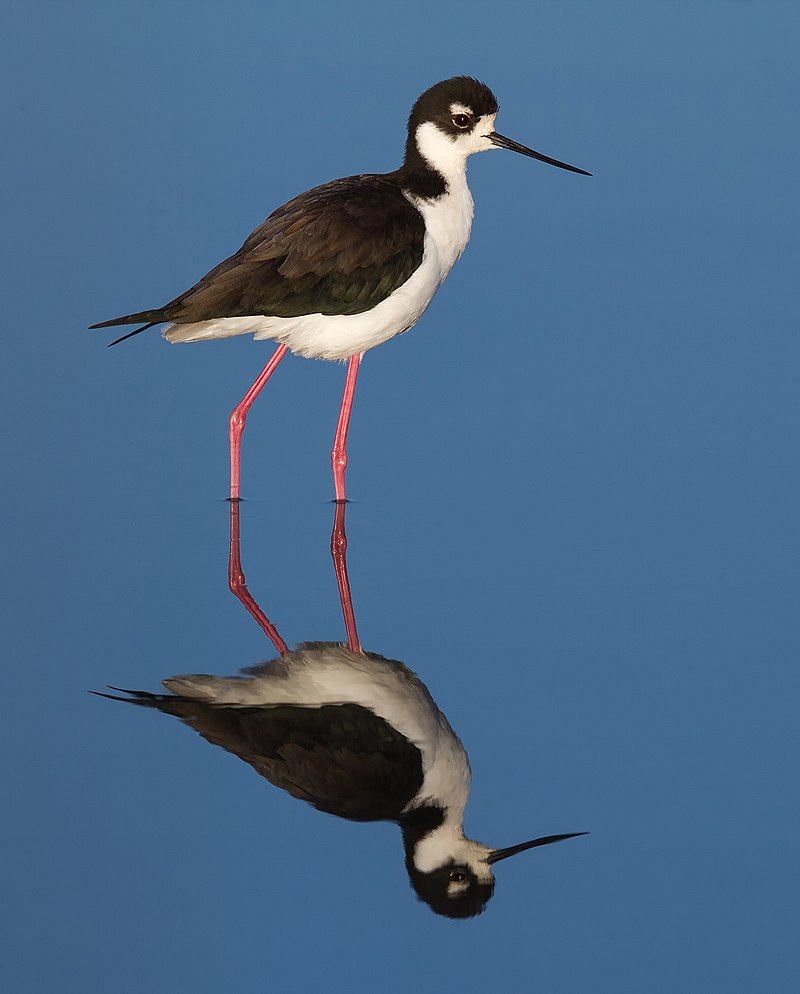
The black-necked stilt is a species of shorebird commonly found in wetlands and coastal areas across the United States.
It is especially abundant in the western U.S., from the coastal regions of California to the interior of the country and along the coastlines of various other states.
The bird can also be found in Mexico, Central America, and the Caribbean. This species is easily identified by its long, pink legs, black and white plumage, and distinct black neck.
The black-necked stilt is a reasonably large shorebird, measuring up to 16 inches long and having a wingspan of up to 25 inches.
It has a long, thin bill that helps it to feed on a variety of small prey, such as insects, small fish, and crustaceans.
The black-necked stilt is a migratory species, typically traveling from its breeding grounds in the Northern Hemisphere to the warmer climates of the Southern Hemisphere during the winter months.
It typically breeds in large colonies, often alongside other species of shorebirds, and its nest is a shallow depression in the ground lined with grass and other material.
The black-necked stilt is an essential species in many wetland ecosystems, as it helps maintain the food web balance by preying on small fish, crustaceans, and insects.
It is also a famous bird for birders and wildlife enthusiasts, as its bright colors and graceful movements make it enjoyable to observe.
| Kingdom | Animalia |
| Phylum | Chordata |
| Class | Aves |
| Order | Charadriiformes |
| Family | Recurvirostridae |
| Genus | Himantopus |
| Species | H. mexicanus |
3. Black-bellied Whistling Duck
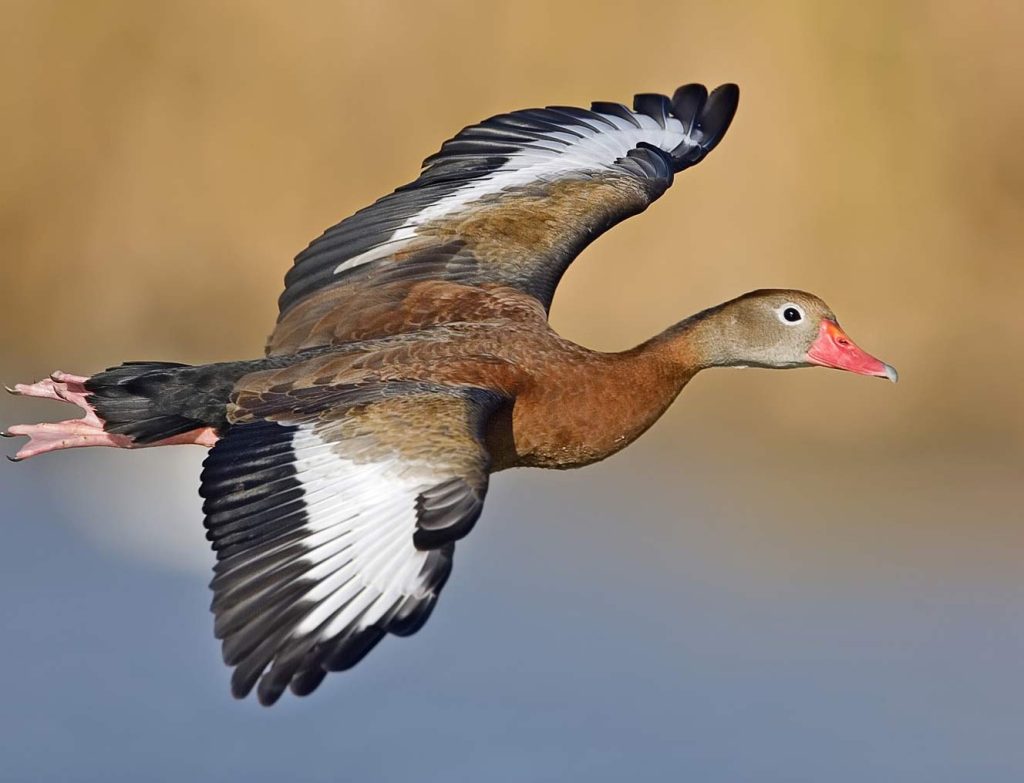
The black-bellied whistling duck was previously known as the black-bellied tree duck and is found in multiple parts of the world.
Before 2000, it mainly bred in the southernmost parts of the United States, Mexico, and tropical Central to south-central South America. This duck species is now found year-round in much of the United States.
The black-bellied whistling duck is recognizable by its black belly and unique whistling sound. It has a long, thin black bill and reddish-brown eyes, and the male is slightly larger than the female.
It has a brownish-black head and neck with a grayish-white stripe along its neck. The body is brownish-black, with white on the front and underside of the wings and a white patch on the back of the wings.
The legs and feet are reddish-brown with a white patch on the toes. The black-bellied whistling duck’s diet consists of insects, seeds, and aquatic plants. It prefers to live near shallow, open bodies of water such as ponds, lakes, and marshes.
It is usually found in small groups and is an active and vocal bird.
It is a good flier and can soar for long distances. Overall, the black-bellied whistling duck is a fascinating duck species with an extensive range of habitats in the United States and other parts of the world.
Its unique whistling sound and ability to fly long distances make it an exciting bird to observe.
| Kingdom | Animalia |
| Phylum | Chordata |
| Class | Aves |
| Order | Anseriformes |
| Family | Anatidae |
| Genus | Dendrocygna |
| Species | D. autumnalis |
4. Rock Pigeon
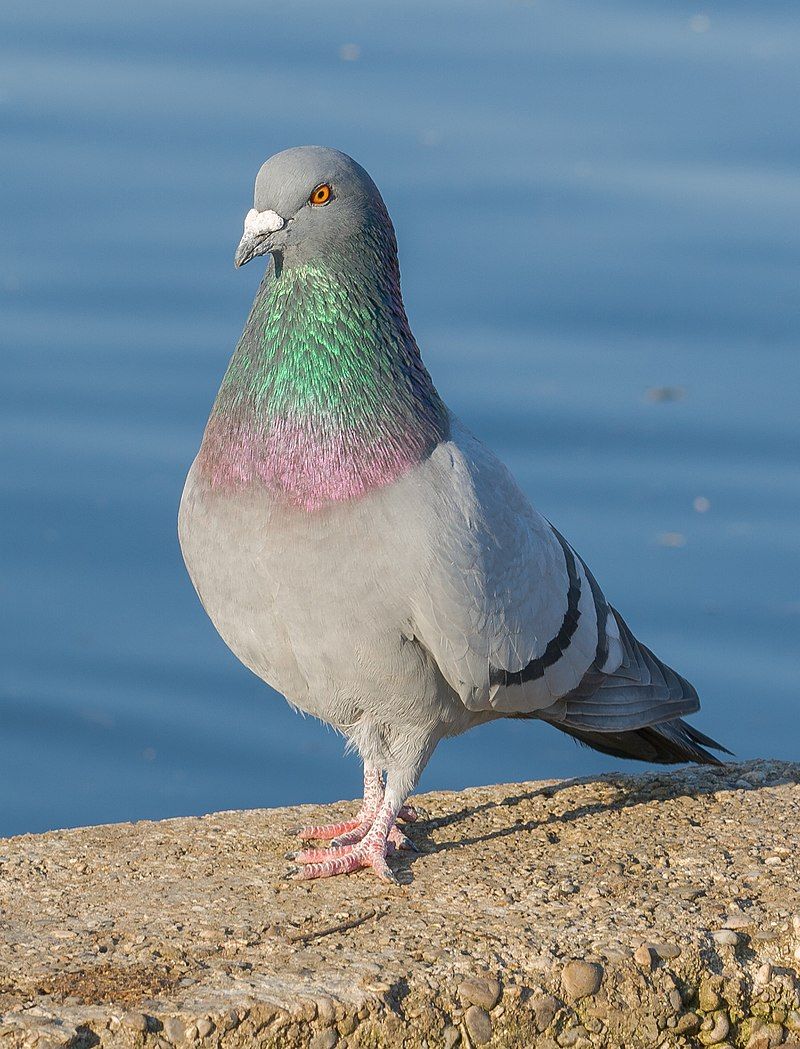
The rock dove, rock pigeon, or common pigeon is a bird species belonging to the Columbidae family. It is commonly referred to as the “pigeon.” This species is the ancestor of the domestic pigeon, frequently found in cities and towns worldwide.
Through domestication, the numbers of pigeons have grown dramatically, and some have escaped and reproduced in the wild, leading to the establishment of sizeable feral pigeon populations.
These feral pigeons can be seen flying around urban areas and are often considered a nuisance.
| Kingdom | Animalia |
| Phylum | Chordata |
| Class | Aves |
| Order | Columbiformes |
| Family | Columbidae |
| Genus | Columba |
| Species | C. livia |
5. Inca Dove
The Inca or Mexican dove is an attractive small bird native to the New World. French surgeon and naturalist René Lesson first discovered and described it in 1847. This species has a length of 16.5–23 cm and weighs 30–58 g.
It also has an average wingspan of 28.5 cm, with a maximum wingspan of 32 cm. The Inca dove is a small dove species, usually grayish-brown, with tan patches on its wings, back, and head. It has a white line that extends from the eye to the nape.
Its tail is tipped with white, and its legs are pink. It has a fast and direct flight and can be seen flitting around trees and shrubs in suburban areas. The Inca dove feeds mainly on seeds and grains. It also eats some insects and berries.
Its diet includes corn, grasses, and weeds. This species nests in trees, shrubs, and other vegetation.
It lays two white eggs that both parents incubate for around two weeks. The Inca dove is found in the southwestern United States, central Mexico, and parts of South America. It is a common species and is not threatened.
It is considered a pest due to its tendency to eat livestock feed. Despite this, it is still a popular species for observation and pretty attractive, making it a favorite among birdwatchers.
| Kingdom | Animalia |
| Phylum | Chordata |
| Class | Aves |
| Order | Columbiformes |
| Family | Columbidae |
| Genus | Columbina |
| Species | C. inca |
6. Eurasian Collared Dove
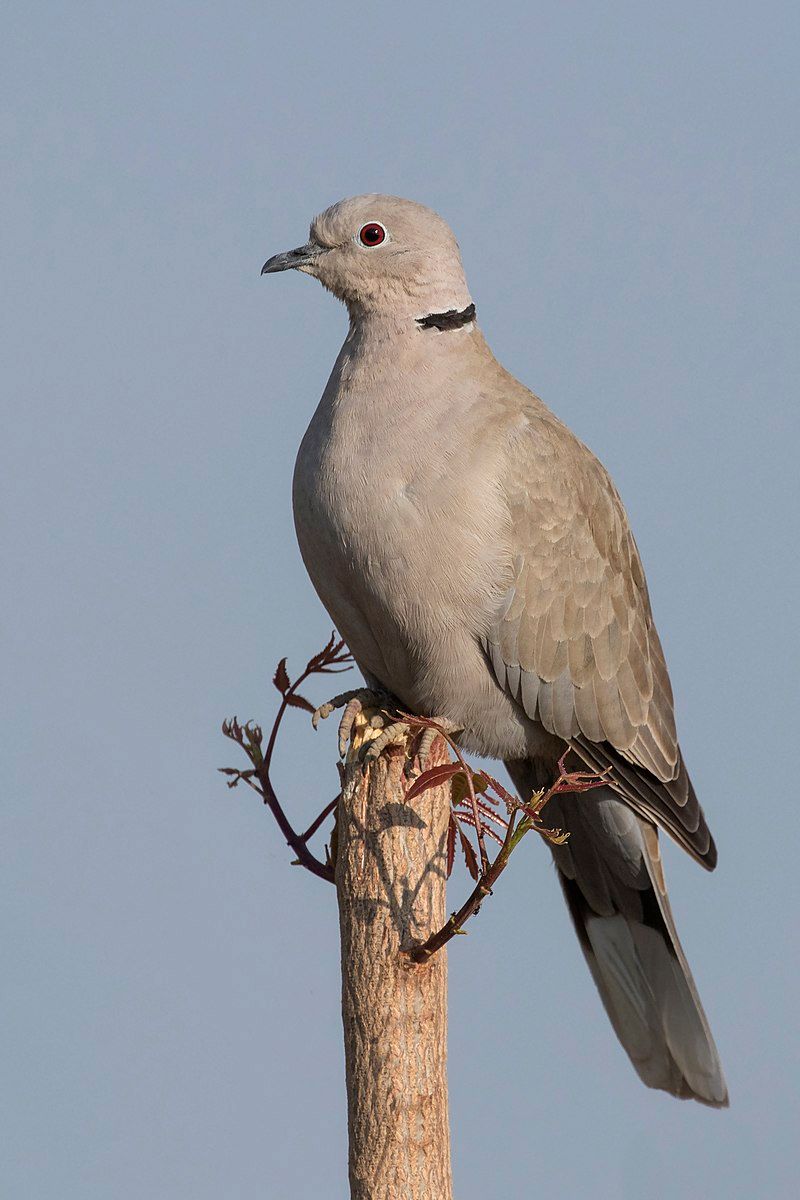
The Eurasian collared dove is a species native to Europe and Asia. It has since been introduced to various other locations, such as Japan, North America, and multiple islands in the Caribbean.
This species has a wide range and a steadily increasing population, so it has been listed as the Least Concern on the IUCN Red List since 2014.
This means the Eurasian collared dove is not currently considered threatened or endangered. The Eurasian collared dove has adapted well to various habitats and can live in both urban and rural areas.
This has allowed the species to expand its range and increase its population size, leading to its status as a species of Least Concern. Its global population is estimated to be over 20 million birds, and its range continues to expand.
The Eurasian collared dove is a medium-sized dove with grayish-brown plumage, a white collar on its neck, and a black half-collar on its throat. It is a vocal species with several different types of calls that are used for communication.
Its diet consists mainly of seeds and grains but will also feed on insects, fruits, and flowers. The Eurasian collared dove is a bird species with a wide range and a steadily increasing population size, leading to its status as a species of Least Concern.
It has adapted well to various habitats and can live in urban and rural areas. Its global population is estimated to be over 20 million birds, and its range continues to expand.
This species has a white collar on the back of its neck and a black half-collar on its throat, and its diet consists mainly of seeds and grains.
| Kingdom | Animalia |
| Phylum | Chordata |
| Class | Aves |
| Order | Columbiformes |
| Family | Columbidae |
| Genus | Streptopelia |
| Species | S. decaocto |
7. Mourning Dove
The mourning dove is a species of bird belonging to the Columbidae family, commonly called the dove family.
Native to North America, this dove species is also known by various names, such as the American mourning dove, rain dove, and turtle dove. In the past, it was referred to as the Carolina pigeon and Carolina turtledove.
Mourning doves are recognized by their small, slim bodies and long, pointed tails. Their greyish-brown feathers are speckled with black, particularly on the wings, and they have a distinctive black spot near the end of their long beaks.
They make a distinctive, loud cooing sound when in flight, which is also how they got their name. Mourning doves are found throughout the United States, Canada, and Mexico. They inhabit various habitats, from woodlands and fields to urban and suburban areas.
They feed primarily on seeds but may consume fruits, insects, and other invertebrates. Mourning doves are monogamous birds, forming strong pairs that may stay together for years.
They usually build their nests in trees, shrubs, or on top of buildings, and they lay 2-4 white eggs at a time. The female incubates the eggs for two weeks while the male brings her food and defends the nest.
The mourning dove is a unique and beautiful bird species, and it is a welcome sight in many North American habitats.
| Kingdom | Animalia |
| Phylum | Chordata |
| Class | Aves |
| Order | Columbiformes |
| Family | Columbidae |
| Genus | Zenaida |
| Species | Z. macroura |
8. Hummingbirds
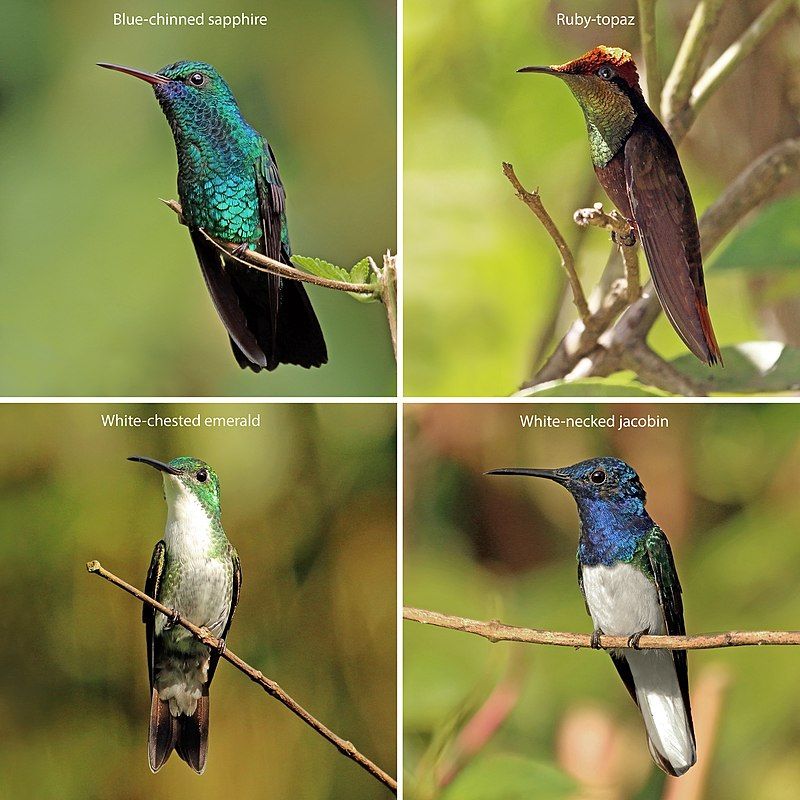
Hummingbirds are a family of birds known as Trochilidae found in the Americas. This family consists of over 366 species, classified into 113 different genera. They are found in various habitats, ranging from Alaska in the north to Tierra del Fuego in the south.
However, most hummingbird species are concentrated in Central and South America, where many of these birds are found in temperate, tropical, and subtropical climates. Hummingbirds are known for their small size, long beaks, and remarkable ability to hover mid-air.
They are also renowned for their vibrant colors, which range from metallic blues and greens to fiery oranges and reds.
In addition, hummingbirds are considered some of the most efficient flyers in the animal kingdom due to their high-speed wing beats, which can reach up to 80 beats per second. Hummingbirds feed primarily on nectar and use their long beaks to get into flowers to retrieve them.
They also feed on small insects and spiders, which can provide them with additional protein sources.
Hummingbirds also use their long tongues to sip nectar from flowers, and they have specially adapted muscles that help them to hover in place while they feed.
Hummingbirds are an essential part of the ecology of the Americas, as they help to pollinate flowers and disperse seeds.
They are also famous for birdwatchers, as they flit from flower to flower in search of food. Hummingbirds are an iconic symbol of the Americas with their bright colors, fast flight, and remarkable abilities.
| Kingdom | Animalia |
| Phylum | Chordata |
| Class | Aves |
| Clade | Strisores |
| Order | Apodiformes |
| Family | Trochilidae |
9. Least Grebe
The least grebe is an aquatic bird that is the smallest of the grebe family. It has an extensive range and can be found in the New World, stretching from the southwestern United States and Mexico to Argentina.
It has also been seen in Trinidad and Tobago, the Bahamas, and the Greater Antilles. This species is adapted to aquatic life and is often seen swimming in ponds, lakes, and marshes. It has a unique courtship ritual involving swimming and calls.
It has an enjoyable diet of small fish, insects, and aquatic vegetation. The least grebe is a valuable species, helping to keep marine ecosystems healthy and balanced.
| Kingdom | Animalia |
| Phylum | Chordata |
| Class | Aves |
| Order | Podicipediformes |
| Family | Podicipedidae |
| Genus | Tachybaptus |
| Species | T. dominicus |
10. Eared Grebe
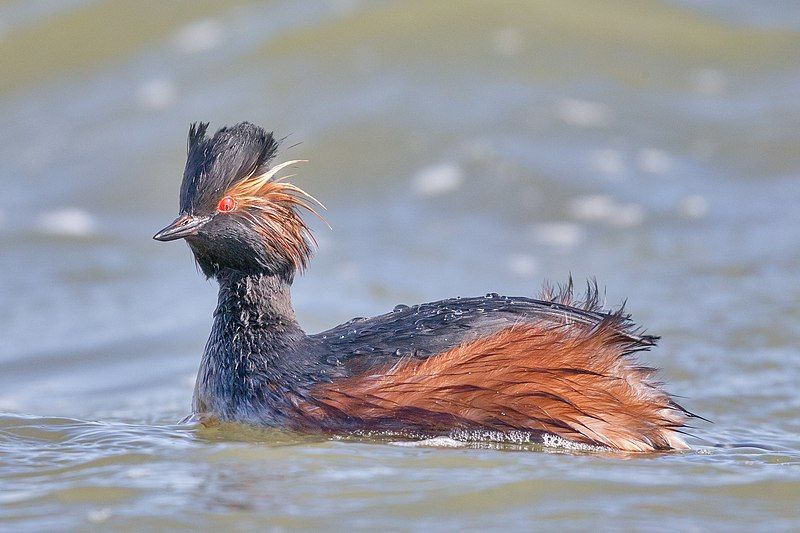
The black-necked grebe, also known as the eared grebe, is a species of water bird belonging to the grebe family. It was first described by Christian Ludwig Brehm in 1831.
Currently, there are three recognized subspecies of this bird, with the nominate subspecies being the most common. These birds have distinctive black and white markings on their neck and head, mainly found near inland and coastal waters.
They typically feed on small fish, crustaceans, insects, and aquatic plants. They are monogamous and highly territorial during the breeding season, with a single pair defending their nesting area.
During this time, they build floating nests made of plant material, often anchored to aquatic vegetation. These birds are highly adapted to marine life, with partially webbed feet, a streamlined body, and a long neck.
They can dive for up to a minute in search of food. In addition, they are excellent swimmers and can move quickly and gracefully in the water. The black-necked grebe is a widespread species, with populations found in Europe, Asia, North America, and South America.
However, their populations have been declining in some areas, mainly due to habitat destruction and the effects of pollution. Because of this, the species is listed as “Near Threatened” on the IUCN Red List.
| Kingdom | Animalia |
| Phylum | Chordata |
| Class | Aves |
| Order | Podicipediformes |
| Family | Podicipedidae |
| Genus | Podiceps |
| Species | P. nigricollis |
11. Pied-billed Grebe
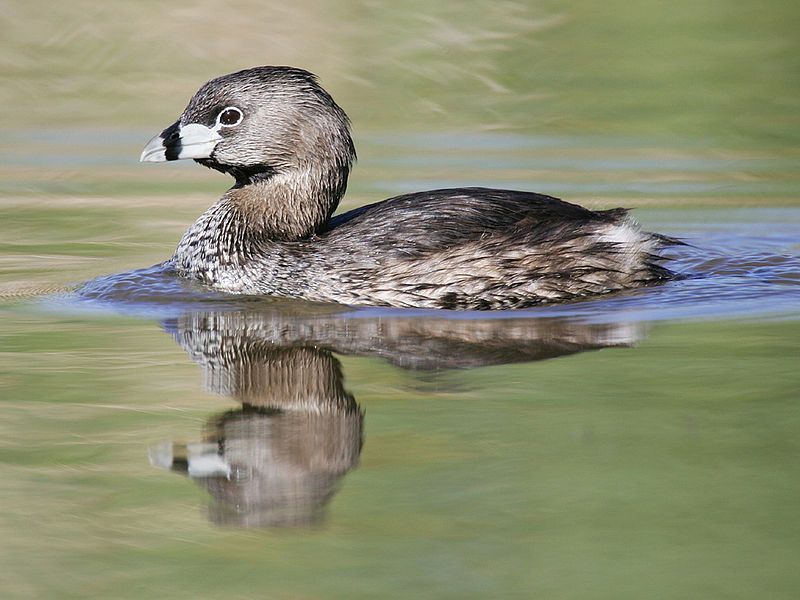
The pied-billed grebe is a species of water bird belonging to the Grebe family. This species is unique because it is the only bird in its genus, Podilymbus, since the extinction of the Atitlán grebe. This bird is commonly found in ponds located throughout the Americas.
It is also known to inhabit other bodies of water, such as marshes, lakes, and slow-moving rivers. The pied-billed grebe is a medium-sized bird with a stout body and a short, thick neck.
It has a large head, a rounded bill with a yellowish-gray coloration, and a black band across the center of the bill. The upperparts are primarily dark brown, while the underparts are white. This bird has short wings and is not a strong flier.
It prefers to swim, dive, and walk on land. The pied-billed grebe is an omnivore that feeds on small fish, aquatic insects, and other aquatic organisms. It nests near or above the water, typically on floating vegetation.
The female lays an average of four eggs, and the chicks can swim and dive soon after hatching. The pied-billed grebe is considered a common species in much of its range. It is threatened by habitat destruction due to human activity and pollution.
Conservation efforts are underway to protect this species and its habitat.
| Kingdom | Animalia |
| Phylum | Chordata |
| Class | Aves |
| Order | Podicipediformes |
| Family | Podicipedidae |
| Genus | Podilymbus |
| Species | P. podiceps |
12. Ruddy Ground-Dove
The ruddy ground dove is a species of small dove native to the tropical regions of the New World. It is a permanent resident in Mexico, Brazil, Peru, Paraguay, northern Argentina, and Trinidad and Tobago.
Occasionally, birds from this species can be spotted in the southwestern United States, in areas such as southern Texas, California, and many others. This occurs primarily during the winter months.
The ruddy ground dove is relatively small, measuring up to 10 cm long and weighing about 25 grams. It has a greyish-brown head, a reddish-brown chest and mantle, and a white throat. Its wings and tail are dark brown, and its underside is pale brown.
The distinctive feature of this species is its white-tipped tail feathers. The ruddy ground dove prefers open wooded habitats but can also be found in more urbanized areas. It feeds mainly on seeds, grains, and other plant matter.
It can also be seen foraging in gardens and other areas where food is available. During the breeding season, the female lays up to two eggs in a nest made of twigs and grass. The ruddy ground dove is a common species and is not considered to be threatened now.
Its population has been stable and is not in any danger of decline. It is a widespread species for birdwatchers, as it is pretty easy to observe in its natural habitat.
| Kingdom | Animalia |
| Phylum | Chordata |
| Class | Aves |
| Order | Columbiformes |
| Family | Columbidae |
| Genus | Columbina |
| Species | C. talpacoti |
13. Banded Quail
The banded quail is a species of bird belonging to the family Odontophoridae. This species is endemic to Mexico, meaning it can only be found in that region.
Its natural habitats range from subtropical and tropical dry forests to dry shrublands, high-altitude shrublands, and heavily degraded former forests.
In other words, the banded quail can inhabit various areas, from dense forests to areas heavily altered by human activity.
In Mexico, the banded quail can be found in various habitats, ranging from tropical and subtropical dry forests to dry shrublands and high-altitude shrublands. Despite its range, the population of banded quail is decreasing due to extensive habitat destruction.
Conservation efforts are necessary to protect this species and its habitats to prevent further population decline.
| Kingdom | Animalia |
| Phylum | Chordata |
| Class | Aves |
| Order | Galliformes |
| Family | Odontophoridae |
| Genus | Philortyx |
| Species | P. fasciatus |
14. Long-tailed Wood Partridge
The long-tailed wood partridge is a species of bird found only in Mexico. It belongs to the family Odontophoridae, also known as the New World quail.
This quail species is a ground-dwelling bird found in various habitats, including evergreen and deciduous forests, brushy areas, and grassland. The long-tailed wood partridge has a long tail, usually erected, and a small head with a short, pointed bill.
The plumage of this species is primarily brown, with black, white, and gray markings. The female is slightly duller in color than the male. These birds feed mainly on vegetables such as seeds, fruits, and leaves.
They also eat insects, small invertebrates, and other small animals. The long-tailed wood partridge is a shy and elusive species rarely seen. It is threatened by habitat destruction, hunting, and other human activities.
| Kingdom | Animalia |
| Phylum | Chordata |
| Class | Aves |
| Order | Galliformes |
| Family | Odontophoridae |
| Genus | Dendrortyx |
| Species | D. macroura |
15. West Mexican Chachalaca
The West Mexican chachalaca is a unique bird species found only in Mexico, belonging to the Cracidae family. This family includes birds such as chachalacas, guans, and curassows, all found in Mexico.
The West Mexican chachalaca is a medium-sized bird, typically measuring 28 and 32 cm long. It has a striking brown and white plumage, with a distinctive white crest, and is renowned for its loud and raucous call.
This species is typically found in large flocks in the forests and woodlands of western Mexico, from the Pacific coast to the northern part of the country. They mainly feed on fruits, seeds, and insects and can often be seen flying and foraging in the trees.
The West Mexican chachalaca is an essential species in the Mexican ecosystem, and its conservation is paramount.
| Kingdom | Animalia |
| Phylum | Chordata |
| Class | Aves |
| Order | Galliformes |
| Family | Cracidae |
| Genus | Ortalis |
| Species | O. poliocephala |
16. Black-billed Cuckoo
The black-billed cuckoo is a species of bird belonging to the Cuculidae family, native to the New World. Its scientific name derives from Ancient Greek, with the genus kokkuzo meaning “to call like a common cuckoo.”
The species name erythropthalmus is derived from two Ancient Greek words – ethnos, meaning “red,” and ophthalmic, meaning “eye.” This is likely a reference to the bird’s distinctive black bill, which has a striking red patch near its base.
This can be easily seen when the bird is in flight. The black-billed cuckoo is found in various habitats, including woodland, forest edges, and shrublands. They are migratory birds and will travel south for the winter months before returning during the spring.
| Kingdom | Animalia |
| Phylum | Chordata |
| Class | Aves |
| Order | Cuculiformes |
| Family | Cuculidae |
| Genus | Coccyzus |
| Species | C. erythropthalmus |
17. Common Nighthawk
The common nighthawk, also known as bullbat, is a species of nightjar found in the Americas. It is a medium-sized bird, typically ranging between 8.5 and 11 inches in length and weighing around 4 ounces.
Its plumage is usually gray or brown, with white markings on its wings and tail. Nighthawks are crepuscular or nocturnal creatures, meaning they are most active at dusk or dawn and during the night. As a result, they are not often seen during the day.
Their presence and identity can be easily determined by their vocalizations, which consist of a low-pitched, drawn-out “boom” sound that can be heard over long distances. Nighthawks feed mainly on insects they catch in the air during their flight.
They build their nests on the ground, usually in open areas. They also roost on artificial structures such as buildings and bridges.
| Kingdom | Animalia |
| Phylum | Chordata |
| Class | Aves |
| Clade | Strisores |
| Order | Caprimulgiformes |
| Family | Caprimulgidae |
| Genus | Chordeiles |
| Species | C. minor |
18. Common Pauraque
The Pauraque, or the Common Pauraque, is a species of nightjar found in subtropical and tropical regions of the Americas. These birds belong to the genus Nyctidromus, a group of two distinct species.
Most of the population of Pauraque remains in the same area throughout the year, except for those found in the northernmost parts of their range.
This bird species feeds mainly on insects found in the darkness of night, which is why they are called nightjars. They have adapted to their environment by having camouflaged coloring, allowing them to blend in.
The Pauraque has relatively short wings and a long tail, which helps it maneuver in hunting and foraging. Additionally, their large eyes help them catch prey in the dark.
The Pauraque is an essential species in the ecosystem as it helps to regulate insect populations.
| Kingdom | Animalia |
| Phylum | Chordata |
| Class | Aves |
| Clade | Strisores |
| Order | Caprimulgiformes |
| Family | Caprimulgidae |
| Genus | Nyctidromus |
| Species | N. albicollis |
19. Northern Bobwhite
The northern bobwhite, also known as the Virginia quail or bobwhite quail, is a ground-dwelling bird native to North America. This species is found in Canada, the United States, Mexico, and Cuba. It has also been introduced to other Caribbean, European, and Asian parts.
The northern bobwhite belongs to a group of birds known as the New World quail. These birds live in various habitats, from grasslands to woodlands, and are known for their distinctive call.
They have plump bodies and small heads, and their feathers are colored in shades of brown, buff, and black. The northern bobwhite is a famous game bird hunted in many areas. It is also a valuable food source and has been domesticated for this purpose in some regions.
| Kingdom | Animalia |
| Phylum | Chordata |
| Class | Aves |
| Order | Galliformes |
| Family | Odontophoridae |
| Genus | Colinus |
| Species | C. virginianus |
20. Mangrove Cuckoo
The Mangrove Cuckoo is a species of cuckoo bird that is native to the Neotropics, which is a tropical region that encompasses Central and South America, as well as the Caribbean and Mexico.
This cuckoo species is distinguishable by its yellow eyes, grey and brown barring on its body, and white throat and belly.
It is a medium-sized bird, measuring around 30 cm in length. The Mangrove Cuckoo is found in various habitats, from mangrove swamps and coastal lagoons to lowland rainforests and open woodlands.
It is an opportunistic feeder, eating whatever it can find, including insects, lizards, frogs, and fruit. The Mangrove Cuckoo is a solitary bird and is rarely seen in flocks. As its name suggests, the Mangrove Cuckoo is strongly associated with mangrove swamps.
It is a pretty vocal species and is most active during the day. While it is not a migratory species, it may move around searching for food or new breeding grounds. Threats to the Mangrove Cuckoo include habitat destruction, hunting, and egg collecting.
Fortunately, this species is still relatively common in many parts of its range.
| Kingdom | Animalia |
| Phylum | Chordata |
| Class | Aves |
| Order | Cuculiformes |
| Family | Cuculidae |
| Genus | Coccyzus |
| Species | C. minor |
21. Mexican Whip-poor-will
The Mexican whip-poor-will is a species of nightjar, a bird type. It is found in the southwestern United States, Mexico, and northern Central America and is considered a medium-sized bird.
Nightjars are characterized by their long wings and short legs, and they are most active at night. They feed on flying insects, which they catch in flight. The Mexican whip-poor-will is grayish-brown, with white and black barring on its wings and tail.
It has a unique call, a long series of whistles that end with a trill. This call is often heard during the early morning or late evening hours.
The Mexican whip-poor-will is listed as a species of “least concern” by the IUCN, but its population is decreasing due to habitat loss. The species is protected in Mexico and the United States, and efforts are being made to conserve and protect its habitat.
| Kingdom | Animalia |
| Phylum | Chordata |
| Class | Aves |
| Clade | Strisores |
| Order | Caprimulgiformes |
| Family | Caprimulgidae |
| Genus | Antrostomus |
| Species | A. arizonae |
22. American Wigeon
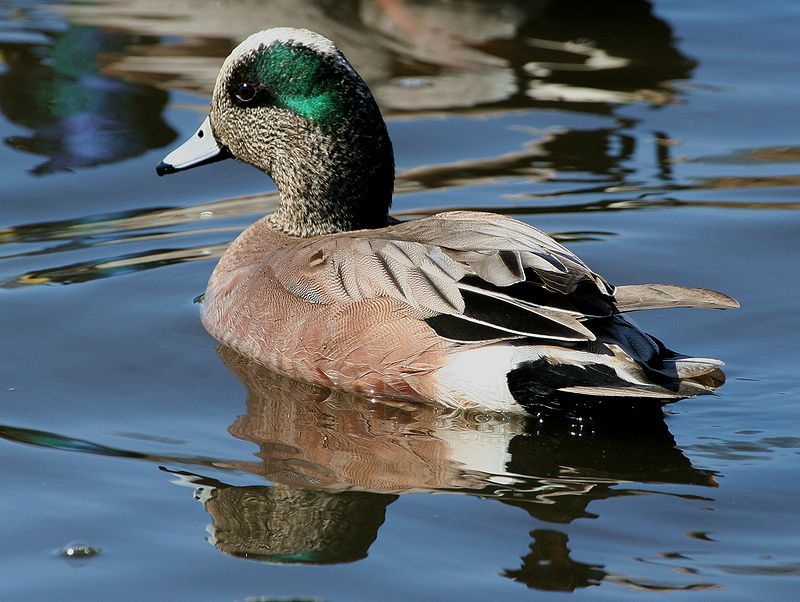
The American wigeon, also known as the baldpate, is a species of duck found exclusively in North America. It has a long history of classification, having been formerly assigned to the genus Anas.
However, modern taxonomy has reclassified the species to fall within the dabbling duck genus Mareca, which includes other wigeon species.
It is the New World counterpart of the Eurasian wigeon, meaning that the American wigeon is the species most similar to the Eurasian wigeon native to the Americas.
This species of duck has a distinctive appearance, featuring a brown head and chestnut-colored body that is easily recognizable in the wild. It is common in wetlands and other aquatic habitats, feeding on aquatic plants and grasses.
The American wigeon is an important species for conservation and is popular among birdwatchers and hunters.
| Kingdom | Animalia |
| Phylum | Chordata |
| Class | Aves |
| Order | Anseriformes |
| Family | Anatidae |
| Genus | Mareca |
| Species | M. Americana |
23. Northern Pintail
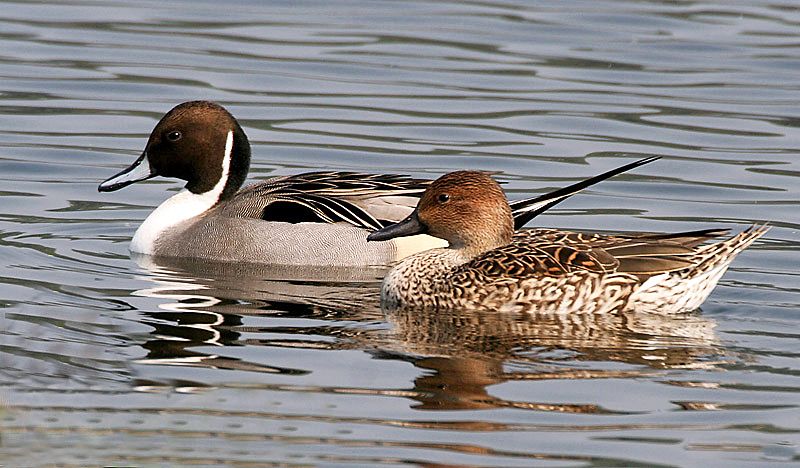
The pintail, or northern pintail, is a species of duck found in many habitats. It is native to the northern areas of Europe, the Palearctic region, and North America.
In the summer, they breed in the northern regions, nesting in wetlands and other areas with abundant water. During winter, they migrate south of their breeding grounds, sometimes traveling as far as the equator.
This species can survive in many climates, including high altitudes and warm temperatures. They are also known for their long, pointed tails, a distinguishing characteristic.
The northern pintail is a highly adaptable species that can thrive in many environments.
| Kingdom | Animalia |
| Phylum | Chordata |
| Class | Aves |
| Order | Anseriformes |
| Family | Anatidae |
| Genus | Anas |
| Species | A. acuta |
24. Eurasian Teal
The Eurasian teal, also known as the common teal or Eurasian green-winged teal, is a species of duck found in many temperate parts of Europe and Siberia.
It is a widespread species and is often referred to simply as the teal since it is the only dabbling duck of its size in much of its range.
The Eurasian teal is a migratory species and will migrate south during the winter months. In terms of its appearance, the Eurasian teal is a small duck with a blue-green head and neck and a grayish-brown body.
Its wings are a lighter shade of brown, and it has a white patch on its cheek. Its bill is a dark greenish, and its legs and feet are yellowish-orange. The Eurasian teal is a social species found in large flocks.
It feeds mainly on aquatic invertebrates and eats small fish or amphibians. It breeds in the spring and summer months and will construct a nest lined with down feathers on the ground.
The female will lay an average of 7 to 12 eggs, which she will incubate for 20 to 24 days until they hatch. The Eurasian teal is a valuable species, both ecologically and economically.
It is an important food source for many predators, and its feathers are often used for fly tying. It is also a famous game bird, and many hunters pursue it for sport.
| Kingdom | Animalia |
| Phylum | Chordata |
| Class | Aves |
| Order | Anseriformes |
| Family | Anatidae |
| Genus | Anas |
| Species | A. crecca |
Conclusion
Birds in Puebla are an essential part of the biodiversity of the region. They are a keystone species, providing pollination, food for other animals, and pest control.
Their presence helps keep the environment healthy and provides a beautiful addition to the landscape.
They are also a source of joy for birdwatchers and anyone who takes the time to enjoy their beauty.